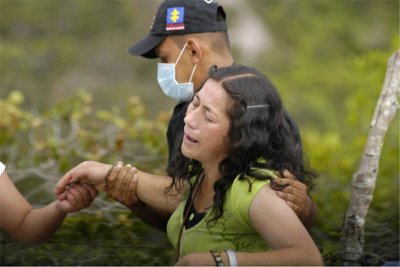The Brazilian media talks a lot about the armed conflict in Colombia, always from the perspective of the Álvaro Uribe government, which has generally been portrayed as a great democratic force that has been doing everything possible to end the civil war that the country has endured for decades. You would never hear or read in Brazilian commercial media about the famous ‘black list’, a document produced by the US Department of Defense, which shows Uribe to be a drugs trafficker. The document is explicit: Álvaro Uribe is a senator (this was in 1991) who collaborates actively with the Medellin cartel, receives money from this and is a personal friend of Pablo Escobar. Perhaps it was for this very reason that the US supported the then senator when he wanted to be president of Colombia, which he has been for two terms. It is not without reason that Uribe has permitted the installation of new US military bases in the Colombian territory.
During the years in which he has led the Colombian government, Uribe has certainly not ceased to be a faitful servant of drug trafficking and it is no wonder that he is now starting a process of war against Venezuela, spreading lies about the connection of the Cháves government with the FARC “terrorists”. He follows the example of his boss, George Bush, when he wanted to wage war on Iraq on the basis of lies like the one about Iraq having chemical weapons.
Firstly, FARC is not formed by terrorists. They are a regular army engaged in armed struggle against the Colombian army and have as a goal to liberate the country. Secondly, Uribe has every interest in keeping outside of the chain, as he is recognised as a drugdealer even by the US and needs to create a smokescreen around himself. Thirdly, during his tenure he promoted so many crimes and atrocities that he shold be tried for crimes against humanity.
Last week, a pit found in the small town of La Macarena, some 200 kilometers from Bogota, a region that is known as one of the ‘hottest’ in the Colombian conflict, revealed a part of the atrocities committed over the years by state terrorism. Over two thousand corpses were found, stacked on top of one another, some with their hands and feet still tied. This is one of the largest mass graves of victims that is known in Latin America. According to colombian newspapers, the pit would have contained corpses since 2005, always renewed.
The Colombian army was quick to say that the bodies were those of guerillas who had died in combat. But the people of the region do not confirm this. On the contrary, what residents are saying is that the bodies are those of social leaders, peasants and popular activists who disappeared without trace.
The grave was discovered because of a complaint made by people who had been working with the paramilitaries for years and who surrendered under the protection of a controversial law called the Law of Justice and Peace. This law guarantees informers a symbolic sentence if they confess their crimes. During these ‘confession’ sessions, one of the leaders of a paramilitary group named John Jairo Renteria revealed that he and his group buried more than 800 people at a farm in the town of Puerto Asis. He also confessed that his men used these people (trade unionists, social activists, students) to learn who to dismember a person and revealed that some procedures were done with people still alive.
The court hearing and the location of the bodies in the La Macarena grave happened on the same day that the government of Santos, colombia’s current president, called an urgent meeting of the Organisation of American States to denounce Venezuela as a state that was welcoming members of the FARC. This was nothing more than another smoke screen to try to cover up the horror of the discovery and many other atrocities committed by the government of his friend and predecessor Álvaro Uribe.
The organised people of Colombia want everything to be clarified and request that Uribe is punished for these crimes against humanity.
Below: photos of the grave discovered in La Macarena.
Translated by Hilde C. Stephansen




